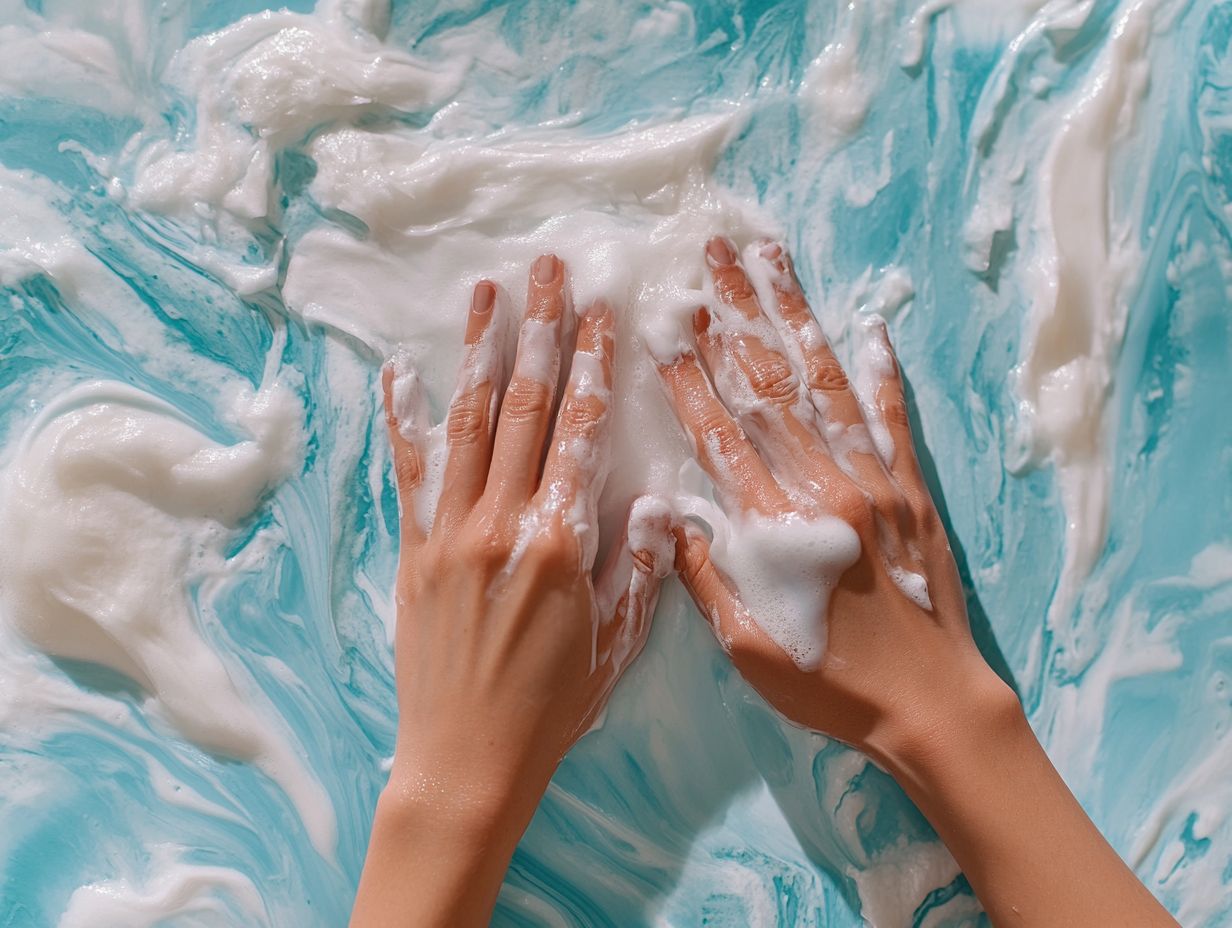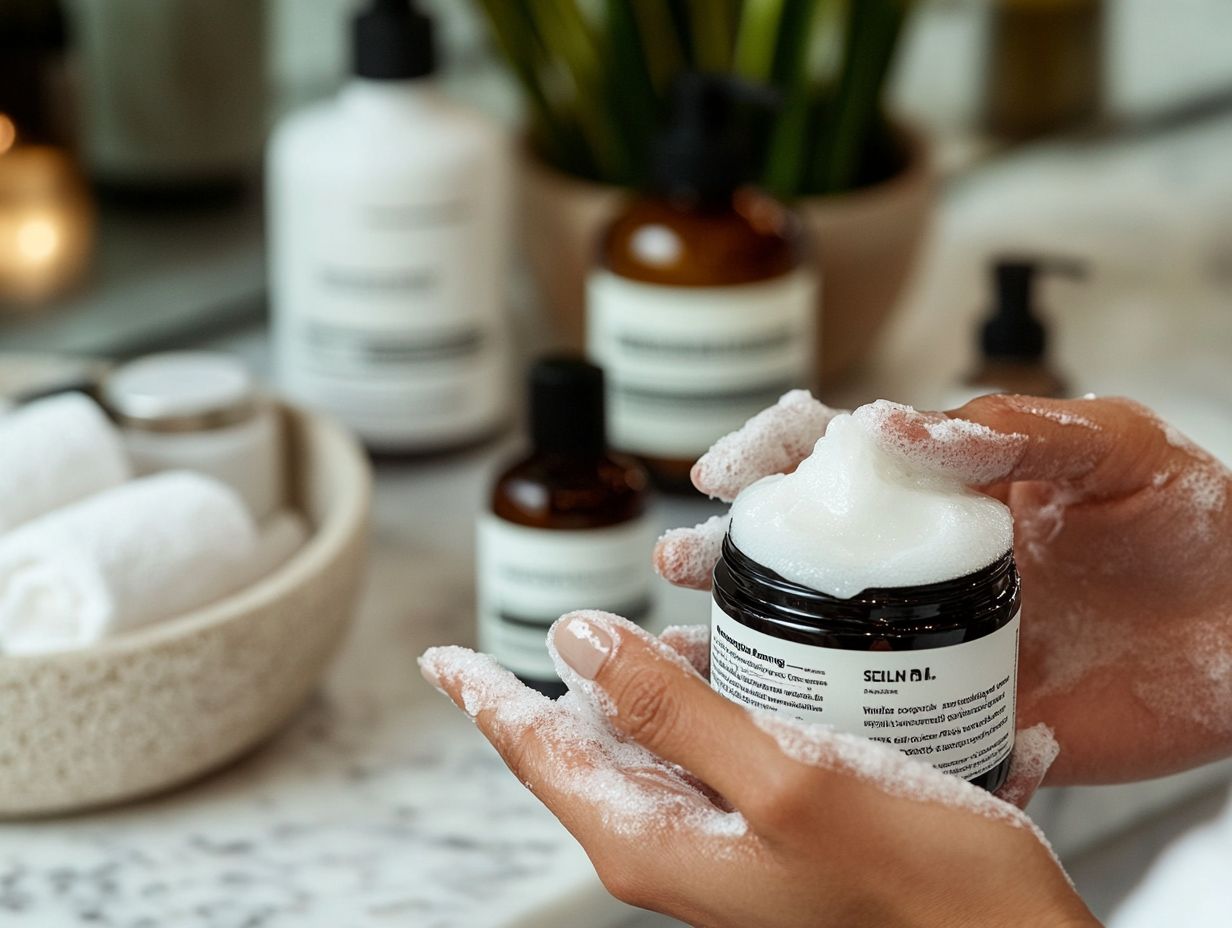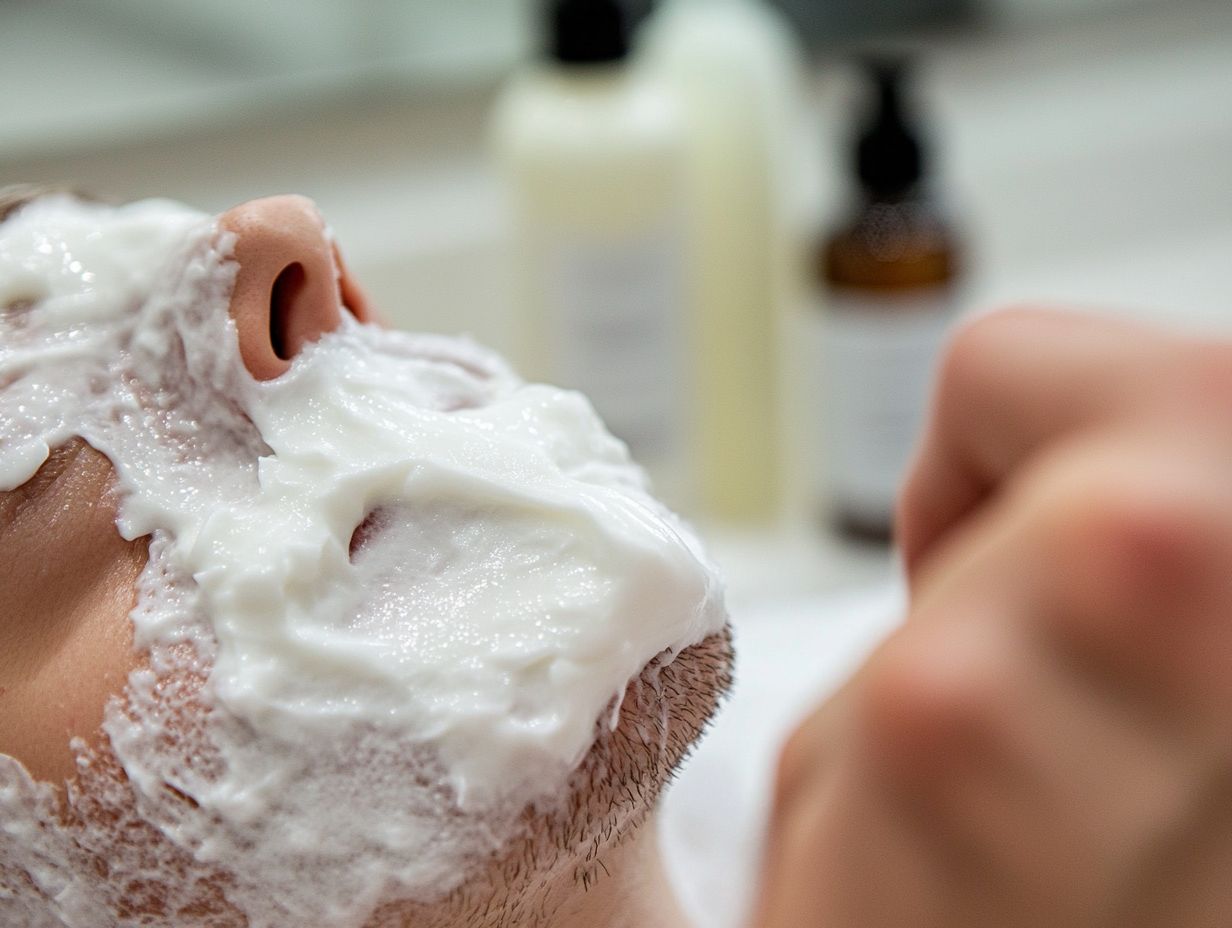Sensitive skin presents unique challenges, particularly when it comes to shaving. Understanding the underlying causes of sensitivity and accurately identifying my skin type is the first crucial step toward achieving a smoother, irritation-free experience.
This guide outlines essential pre-shave preparations, effective shaving techniques, and post-shave care specifically designed for sensitive skin. Moreover, it delves into long-term management strategies to ensure my skin remains healthy and comfortable. By implementing these practices, I can say goodbye to nicks and irritation—my journey to better skin begins here.
Key Takeaways:
Understanding Sensitive Skin

Understanding sensitive skin is essential for those who often experience irritation, such as razor burn and redness, particularly during shaving.
Sensitive skin can respond adversely to a variety of products and techniques, resulting in discomfort and potential issues like folliculitis and ingrown hairs.
Effectively managing sensitive skin requires recognizing its specific needs, choosing appropriate shaving products, and implementing a comprehensive skincare routine to ensure overall skin health.
“`html
By grasping the factors that contribute to sensitivity, I can better protect my skin, achieve optimal hydration, and promote healing after shaving. For more tips, check out How to Care for Sensitive Skin After Shaving.
“`
What Causes Sensitive Skin?
Sensitive skin can result from a variety of factors, including environmental influences, genetic predisposition, and certain shaving techniques that can worsen skin irritation. Common triggers for sensitivity include harsh weather conditions, exposure to allergens, and the use of irritating skincare products, which can lead to increased redness and discomfort.
In my experience, individuals with a family history of skin conditions often find that their skin reacts more intensely to external stimuli, underscoring the significant role genetics play in sensitivity. Additionally, exposure to pollutants or extreme temperatures can compromise the skin barrier, making it more susceptible to irritation.
Improper shaving techniques, such as using dull blades or shaving against the grain, can exacerbate this issue, resulting in nicks and inflammation.
To minimize sensitivity, it is essential for individuals to carefully select skincare and shaving products specifically formulated for delicate skin. These products can help restore balance and alleviate irritation effectively.
Identifying Your Skin Type
Identifying my skin type is essential for effective skincare, as different types respond uniquely to various products and treatments. For example, I’ve found that sensitive skin often requires gentle, hydrating formulations to minimize irritation.
By understanding my skin’s characteristics—whether it’s oily, dry, or sensitive—I can make informed decisions when selecting suitable shaving and skincare products that promote skin health and comfort.
Sensitive skin is characterized by heightened reactivity, often showing signs like redness, itching, or a burning sensation, particularly when exposed to harsh ingredients or environmental factors. This differs from other skin types, such as oily skin, which may be able to tolerate stronger formulations but still struggle with excess shine.
As a result, I prioritize a tailored skincare routine. For my sensitive skin, incorporating calming agents along with consistent hydration has proven effective in strengthening the skin’s barrier function and building resilience against irritants.
I recognize that prioritizing moisturization is crucial; it not only alleviates discomfort but also enhances the overall appearance of my skin, supporting its long-term health and vitality.
Pre-Shave Preparation for Sensitive Skin

Pre-shave preparation is a crucial step for me, especially considering my sensitive skin. It significantly helps to prevent irritation and ensures a smoother shaving experience.
I find that effective preparation involves thoroughly cleansing and exfoliating my skin to remove dead cells and impurities. After that, I apply suitable shaving products specifically designed for the unique needs of sensitive skin.
This routine not only promotes optimal skin hydration but also minimizes the risk of razor burn, redness, and overall shaving discomfort.
Cleansing and Exfoliating
Cleansing and exfoliating are essential steps in preparing my sensitive skin for shaving, as they effectively remove dirt, oils, and dead skin cells that can lead to irritation. For sensitive skin, it is crucial to use gentle cleansers and exfoliants that preserve the moisture barrier, ensuring proper hydration and protection throughout the shaving process.
I find that incorporating a soothing, non-irritating cleanser greatly enhances my cleansing routine. I specifically look for products featuring calming ingredients like chamomile or aloe vera, which help to reduce redness and inflammation.
For exfoliation, I opt for gentle formulations containing mild exfoliants such as lactic acid or oatmeal. These allow me to slough away dead skin cells without applying undue stress to my skin. Such products promote optimal skin health, enhancing my comfort and ensuring a smoother shaving experience.
Post-shave, I prioritize maintaining adequate hydration with a nourishing moisturizer. This step is crucial to prevent dryness and discomfort, helping my skin remain balanced and serene.
Choosing the Right Shaving Products
Choosing the right shaving products is essential for those of us with sensitive skin, as using the wrong formulations can worsen irritation and lead to problems such as razor bumps and ingrown hairs.
I find that products specifically designed for sensitive skin, like hydrating shaving creams and gels enriched with soothing ingredients such as aloe vera or vitamin E, can significantly minimize discomfort while ensuring a smooth shave.
Along with these key ingredients, I always look for products that contain natural oils or shea butter. These components provide an extra layer of moisture and protection, allowing the razor to glide effortlessly without causing friction.
It’s also important to consider the shaving technique employed; using a gentle hand and properly preparing the skin can greatly enhance the overall experience. For optimal results, I incorporate a post-shave balm that contains calming agents like chamomile or calendula, which can further soothe irritation and promote skin recovery after shaving.
By thoughtfully combining quality products with proper techniques, I am able to achieve a closer, more comfortable shave, even with sensitive skin.
Proper Shaving Techniques for Sensitive Skin

I understand that proper shaving techniques are crucial for individuals with sensitive skin to prevent irritation and achieve a comfortable shave.
This includes knowing how to shave in the right direction, using a sharp razor, and maintaining proper razor care.
By employing the correct shaving techniques, I can significantly reduce the risk of razor burn, redness, and other forms of skin irritation, ultimately leading to a smoother and more enjoyable shaving experience.
Using a Sharp Razor and Shaving in the Right Direction
Using a sharp razor and shaving in the appropriate direction are essential components of my effective shaving routine for sensitive skin. I’ve learned that dull blades can tug at the skin, increasing the likelihood of irritation and razor burn. By shaving with the grain instead of against it, I can significantly reduce friction and discomfort while achieving a smoother finish.
Maintaining the health of my sensitive skin is crucial, and employing the right shaving techniques has made a remarkable difference. I make it a point to regularly replace my blades to ensure they remain effective, as this not only enhances comfort but also minimizes the risk of cuts.
Prepping my skin with warm water and a suitable shaving cream further cushions it against the razor. After shaving, I always soothe my skin with a gentle moisturizer to lock in hydration and alleviate any potential irritation. These practices not only contribute to a healthier shaving experience but also play a significant role in my overall skin health and comfort.
Avoiding Irritation and Nicks
Avoiding irritation and nicks during shaving is essential for individuals with sensitive skin, as these issues can lead to prolonged discomfort and post-shave complications. I have found that implementing proper shaving techniques—such as applying light pressure and keeping the skin taut—significantly minimizes the risk of cuts and irritation.
Selecting the right products is also crucial for achieving a smoother shaving experience. I prefer using a high-quality shaving cream or gel that contains soothing ingredients like aloe vera or chamomile. These products create a protective barrier against the blade, reducing friction and helping to prevent irritation.
Furthermore, using a sharp, clean razor is vital. Dull blades can tug at the skin, which only exacerbates sensitivity. After shaving, I always apply a gentle, alcohol-free aftershave balm to hydrate and calm the skin. This step not only mitigates redness and discomfort but also promotes healing.
By incorporating these strategies into my shaving routine, I have experienced a much more pleasant and irritation-free experience.
Post-Shave Care for Sensitive Skin

Post-shave care is essential for maintaining skin health, particularly for sensitive skin that may be susceptible to irritation, redness, and razor burn.
I find that using the right aftershave products, such as soothing lotions or creams, coupled with hydrating moisturizers, significantly aids in skin healing.
This approach also provides the necessary protection against external irritants, ensuring my skin remains healthy and comfortable.
Cooling and Soothing the Skin
Cooling and soothing the skin after shaving is essential for individuals with sensitive skin, as it alleviates discomfort and reduces redness. I find that products containing aloe vera or hydrocortisone cream are particularly effective for this purpose. These ingredients offer anti-inflammatory properties that help calm irritated skin and enhance the overall post-shave experience.
Along with aloe vera and hydrocortisone, I also consider options like chamomile extract and calendula, which can significantly boost the soothing effect. These are ideal choices for those prone to irritation.
When applying these products, I prefer to gently pat them onto the freshly shaved area rather than rubbing, as this minimizes the risk of further irritation. It is also advisable to allow the skin some time to absorb these cooling agents for a few minutes before applying a moisturizer.
Incorporating these cooling elements into my post-shave care not only aids in recovery but also contributes to long-term skin health by reducing the risk of razor burn and ingrown hairs.
Moisturizing and Protecting the Skin
Moisturizing and protecting the skin after shaving is essential for my sensitive skin, as it helps replenish lost hydration and creates a protective barrier against environmental irritants. I find that using a nourishing aftershave or moisturizer that contains skin nutrients significantly enhances hydration and resilience, which reduces the likelihood of post-shave irritation.
When selecting the right products, I prioritize those specifically formulated for sensitive skin, which are often labeled as hypoallergenic and fragrance-free. I look for ingredients like aloe vera, hyaluronic acid, or shea butter, as they provide soothing benefits.
By incorporating these practices into my routine, I not only keep my skin smooth but also aid in healing any micro-cuts or inflammation that may occur from shaving.
Regular use of an aftershave helps maintain skin balance and prevent dryness, while a high-quality moisturizer ensures that hydration lasts throughout the day, making it a vital component of my skincare regimen.
Long-Term Management of Sensitive Skin
Managing sensitive skin over the long term requires me to establish a consistent skincare routine that emphasizes hydration, protection, and gentle care, especially regarding shaving frequency and techniques.
By incorporating effective products and practices specifically designed for sensitive skin, I can minimize irritation and promote the maintenance of healthy, resilient skin over time.
Creating a Skincare Routine
Creating a skincare routine for sensitive skin is essential for maintaining optimal skin health and minimizing irritation. I focus on including moisturizing, protection from environmental factors, and targeted topical treatments in my routine. A well-structured regimen tailored to my skin’s specific needs can significantly reduce the likelihood of discomfort associated with shaving and other skincare practices.
Along with these foundational elements, I prioritize selecting gentle, fragrance-free products to mitigate the risk of irritation. Incorporating a hydrating serum enhances moisture retention, while broad-spectrum sunscreen offers protection against harmful UV rays and environmental aggressors.
I also find that using soothing ingredients like aloe vera or chamomile provides additional relief from redness and inflammation.
I employ gentle application techniques, such as patting rather than rubbing, to further minimize discomfort and support my skin’s natural barrier. Ultimately, understanding my skin type and making thoughtful product choices is crucial for developing an effective and nurturing skincare routine.
Preventing Future Irritation and Sensitivity
Preventing future irritation and sensitivity requires a proactive approach to skincare, especially when it comes to shaving techniques and product formulation. By implementing gentle methods, avoiding known irritants, and utilizing protective measures, I can significantly enhance my skin’s resilience and minimize the chances of experiencing discomfort.
Choosing the right products is crucial; I make it a point to select those labeled as fragrance-free and hypoallergenic to reduce the potential for reactions. I also incorporate soothing ingredients like aloe vera or chamomile to help calm my skin during and after hair removal.
Additionally, I prioritize proper shaving techniques, such as using a sharp blade and shaving in the direction of hair growth, to avoid unnecessary tugging or irritation. Regular gentle exfoliation plays a role in preventing ingrown hairs, which are a common source of discomfort.
By being aware of my personal triggers, whether they are specific products or environmental factors, I can craft a skincare routine that nurtures my skin rather than aggravates it.


